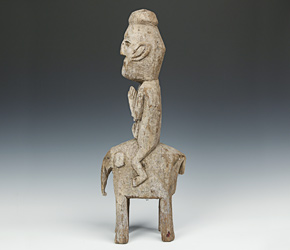Bridge Watcher Figure on Elephant
 |
|
This beautifully weathered wooden guardian figure is a Bridge Watcher from the Jajarkot area of West Nepal. Such guardian figures were placed at shamanic shrines, springs, bridges, and cross roads where they represent apotheosized ancestors and assumed the duty of fending off malevolent entities and other dangers, believed to congregate in such areas. Bridge Watchers are typically found in a “classic canon,” hands meeting in meditation while they gaze face forward. This particular piece is unusual in that it is riding an elephant.
 |
|
Elephants are an important symbol of status, wealth and accomplishment in Northern India and the Himalayas, as they are typically only available to those who can afford to purchase and maintain them. They are important domesticated animals of labor, and can help move large quantities of goods from one market to another, or move large amounts of land or architecture with a skilled handler in control. It is safe to say this Bridge Watcher came from a wealthy household or village.
This piece was originally made by the Newar people, who inhabit the Jajarkot region. The Newar originally came from Mongolia, but have inhabited Nepal for around 2,000 years. They practice a variety of religious views, but generally either Hinduism or Buddhism blended with a traditional form of Animism – this accounts for the belief in the power of statues like Bridge Watchers.
Download this Article: Bridge Watcher Figure on Elephant.pdf